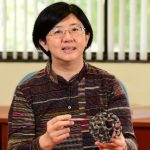Educational Qualifications
1976-1980 Nanyang Technological University, Bachelor
1980-1983 West Virginia University, Master
1983-1987 Cornell University, Ph.D.
Research Areas
Plant pathology, virology, molecular biology, structural biology, biotechnology, nanotechnology.
Research Interests
Molecular biology of plant viruses, discovery of new viruses, virus replication and translation mechanisms, rapid and sensitive detection of viruses, synergism in virus-virus and virus-host Interactions, virus novel gene functions, protein expression using plant viral vectors, virus resistant transgenic plants, structural biology and bioinformatics of viruses, use of plant viruses as nano-materials for drug delivery, RNA interference.
Research Accomplishments
- Determination of full-length sequences and generation of biologically-active cDNA clones of two most prevalent orchid viruses – CymMV and ORSV.
- Discovery of two novel open reading frames from HCRSV and a polyA tract in HLSV.
- Molecular characterization of AYVV, CMV and ZYMV.
- Successful application of non-radioactive cRNA probes, polymerase chain reaction, capillary electrophoresis, molecular beacons and quartz crystal microbalance for plant virus detection.
Representative Publications
[1] Liu HQ, Zhou YJ, Xu QF and Wong SM. (2020). Selection of DNA aptamers for subcellular localization of RBSDV P10 protein in the midgut of small brown planthoppers by emulsion PCR‐based SELEX. Viruses 12, 1239. doi:10.3390/v12111239.
[2] Wu C, Kannan S, Verma CS, Swaminathan K and Wong SM. (2020). Molecular modeling and interaction between Arabidopsis sulfite oxidase and the GW motif of Turnip crinkle virus coat protein. Virology 551: 64-74.
[3] Yang X, Das PP, Oppenheimer P, Zhou GH and Wong SM. (2020). iTRAQ-based protein analysis provides insight into heterologous superinfection exclusion with TMV-43A against CMV in tobacco (Nicotiana benthamiana) plants. J Proteome 229: 103948. https://doi.org/10.1016/j.jprot.2020.103948.
[4] Guo S and Wong SM. (2020). Small RNA derived from Tobacco mosaic virus targets a host C2-domain abscisic acid-related (CAR) 7-like protein gene. Phytopathol. Res. 2: 15. https://doi.org/10.1186/s42483-020-00058-7.
[5] Yang ZT, Wong SM and Yue GH. (2020). Characterization of GAB3 and its association with NNV resistance in the Asian seabass. Fish & Shellfish Immunol.104: 18-24.
[6] Ren R, Gao J, Lu CQ, Wei YL, Jin JP, Wong SM, Zhu GF and Yang FX. (2020). Highly efficient protoplast Isolation and transient expression system for functional characterization of flowering related genes in Cymbidium orchids. Int. J. Mol. Sci. 21, 2264; doi:10.3390/ijms21072264.
[7] Yang ZT, Wang L, Wong SM and Yue GH. (2020). The HIF1αn gene and its association with hypoxia tolerance in the Asian seabass. Gene 731: 144341. https://doi.org/10.1016/j.gene.2020.144341
[8] Guo S and Wong SM. (2020). A conserved carboxylesterase inhibits Tobacco mosaic virus (TMV) accumulation in Nicotiana benthamiana plants. Viruses 12, 195; doi:10.3390/v12020195
[9] Macharia M, Das PP, Naqvi NI and Wong SM. (2020). iTRAQ-based quantitative proteomics reveals a ferroptosis-like programmed cell death in plants infected by a highly virulent tobacco mosaic virus mutant 24A+UPD. Phytopathol. Res. 2:1. https://doi.org/10.1186/s42483-019-0043-5
[10] Wu W, Liu HQ, Dong Y, Zhang Y, Wong SM, Wang CC, Zhou YJ and Xu QF. (2019). Determination of suitable RT-qPCR reference genes for studies of gene functions in Laodelphax striatellus (Fallén). Genes. 10.887. doi 10.3390/genes 10110887
[11] Guo S and Wong SM. (2019). Poly(A) introduced upstream of the upstream pseudoknot domain of Tobacco mosaic virus led to sequence deletion after serial passaging in host plants. Phytopathol. Res. 1:24.
[12] Macharia MW, Tan WYZ, Das PP, Naqvi NI and Wong SM. (2019). Proximity-dependent biotinylation screening identifies NbHYPK as a novel interacting partner of ATG8 in plants. BMC Plant Biology 19:326.
[13] Das PP, Macharia MW, Lin QS and Wong SM. (2019). In planta proximity-dependent biotin identification (BioID) identifies a TMV replication co-chaperone NbSGT1 in the vicinity of 126 kDa replicase. J Proteome 204: 103402
Website
https://www.dbs.nus.edu.sg/staffs/wong-sek-man/?cid=59 ?











